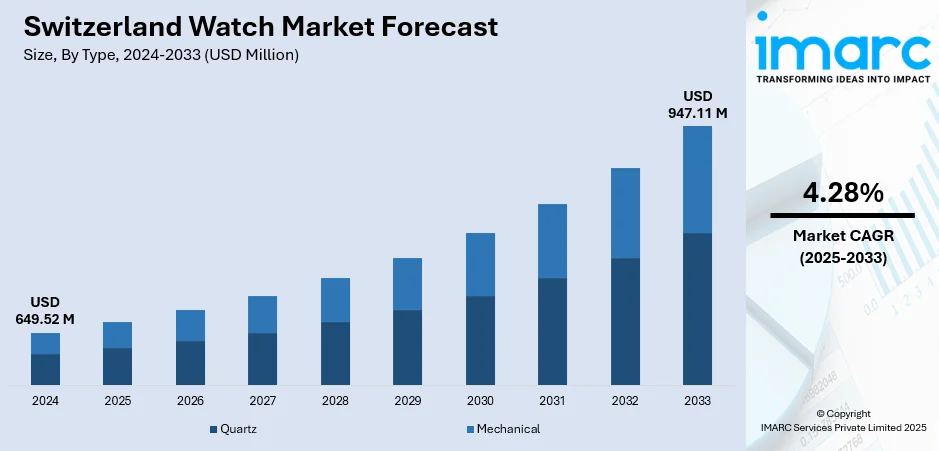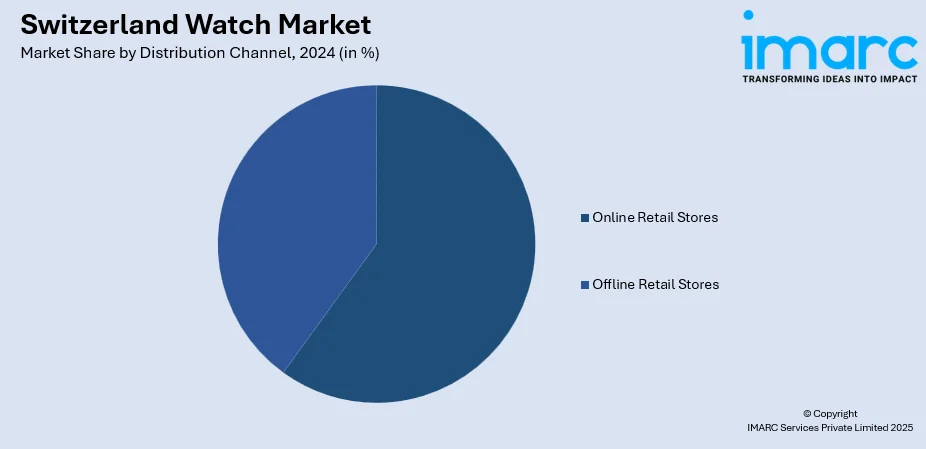
Switzerland Watch Market Size, Share, Trends and Forecast by Type, Price Range, Distribution Channel, End User, and Region, 2025-2033
Switzerland Watch Market Overview:
The Switzerland watch market size reached USD 649.52 Million in 2024. The market is projected to reach USD 947.11 Million by 2033, exhibiting a growth rate (CAGR) of 4.28% during 2025-2033. The market is shaped by a legacy of precision craftsmanship, luxury branding, and evolving consumer demands. A robust focus on heritage, innovation, and design remains a driving force across segments, both mechanical and smartwatches. Distribution through retail and e-commerce channels has made the watches more accessible, and customization and sustainability are becoming increasingly significant among consumers. With mixed offerings at different price points and user categories, major players are increasing market presence to stay competitive in the changing Switzerland watch market share.
|
Report Attribute
|
Key Statistics
|
|---|---|
|
Base Year
|
2024
|
|
Forecast Years
|
2025-2033
|
|
Historical Years
|
2019-2024
|
| Market Size in 2024 | USD 649.52 Million |
| Market Forecast in 2033 | USD 947.11 Million |
| Market Growth Rate 2025-2033 | 4.28% |
Switzerland Watch Market Trends:
Luxury Demand Reshapes Market Structure
On April 8, 2024, Swiss industry data showed that timepieces priced above CHF 25,000 accounted for total export value. This signals a deeper shift in the market toward premium mechanical watches that prioritize craftsmanship and long-term value over mass production. As interest in entry-level and mid-range segments continues to decline, ultra-luxury models are taking center stage fueled by collectors and buyers seeking exclusivity, heritage, and emotional resonance. The focus is no longer on producing more units, but on creating timepieces that carry cultural weight and artisanal depth. This market polarization is influencing how watches are developed, marketed, and sold. Retail spaces are evolving into curated environments that highlight provenance, storytelling, and personal connection, while digital platforms increasingly cater to connoisseurs. Even small-scale ateliers are finding new audiences through this emphasis on rarity and symbolic value. The growing preference for fewer, more meaningful purchases is reshaping the industry’s foundation. This rising premium focus is playing a key role in driving Switzerland watch market growth.

To get more information on this market, Request Sample
Material Innovation Influencing Design Strategy
In September 2024, industry updates showed a notable dip in monthly exports from key Swiss watchmaking regions. This has intensified focus on material innovation, as brands look to offset rising costs without compromising design integrity. Instead of relying heavily on traditional precious metals like gold, many watchmakers are exploring alternatives such as steel, ceramic, and titanium materials that offer both durability and visual appeal. The shift isn’t about reducing quality but about reimagining luxury through refined finishes, lighter cases, and modern aesthetics. These materials are not only more cost-effective but also align with a growing consumer preference for subtle sophistication and long-term value. Buyers now look beyond weight and price tags, focusing instead on craftsmanship, sustainability, and distinctiveness. This change is allowing Swiss watchmakers to maintain heritage appeal while adapting to contemporary tastes. As the market evolves, material choices are becoming central to product identity and storytelling, helping brands stay relevant and competitive. This shift toward thoughtful design and practical elegance is helping define current Switzerland watch market trends.
Craftsmanship as a Premium Value Driver
In May 2025, Swiss watchmakers emphasized their continued focus on mechanical movements and hand-finished detailing highlighting why these timepieces consistently rank among the most valued in global luxury. At the heart of this perception is craftsmanship: traditional watchmaking techniques, hundreds of manual assembly steps, and precise mechanical engineering form the core appeal. This focus on heritage has become even more important as consumers increasingly weigh long-term value and emotional connection in their purchases. Rather than chasing trends or volume, the Swiss watch industry is reinforcing its reputation by leaning into artisanal quality, with movement complexity and material authenticity becoming key selling points. Buyers are now more informed and selective, often viewing their watches as personal statements or heirlooms rather than accessories. This shift has supported the industry’s pricing resilience and helped insulate premium categories from short-term demand shifts. As global markets evolve, the deep-rooted emphasis on fine craftsmanship and precision engineering continues to define how Swiss watchmaking is positioned in the luxury landscape.
Switzerland Watch Market Segmentation:
IMARC Group provides an analysis of the key trends in each segment of the market, along with forecasts at the country and regional levels for 2025-2033. Our report has categorized the market based on type, price range, distribution channel, and end user.
Type Insights:
- Quartz
- Mechanical
The report has provided a detailed breakup and analysis of the market based on the type. This includes quartz and mechanical.
Price Range Insights:
- Low-Range
- Mid-Range
- Luxury
A detailed breakup and analysis of the market based on the price range have also been provided in the report. This includes low-range, mid-range, and luxury.
Distribution Channel Insights:

- Online Retail Stores
- Offline Retail Stores
The report has provided a detailed breakup and analysis of the market based on the distribution channel. This includes online retail stores and offline retail stores.
End User Insights:
- Men
- Women
- Unisex
A detailed breakup and analysis of the market based on the end user have also been provided in the report. This includes men, women, and unisex.
Regional Insights:
- Zurich
- Espace Mittelland
- Lake Geneva Region
- Northwestern Switzerland
- Eastern Switzerland
- Central Switzerland
- Ticino
The report has also provided a comprehensive analysis of all the major regional markets, which include Zurich, Espace Mittelland, Lake Geneva Region, Northwestern Switzerland, Eastern Switzerland, Central Switzerland, and Ticino.
Competitive Landscape:
The market research report has also provided a comprehensive analysis of the competitive landscape. Competitive analysis such as market structure, key player positioning, top winning strategies, competitive dashboard, and company evaluation quadrant has been covered in the report. Also, detailed profiles of all major companies have been provided.
Switzerland Watch Market News:
- April 2025: Switzerland’s storied watchmaker Corum has returned to full Swiss ownership through a management buyout led by its International Sales Director, Haso Mehmedovic, and supported by Swiss luxury and finance investors. Based in La Chaux‑de‑Fonds, the brand aims to reaffirm its identity rooted in bold design and technical innovation. Under Mehmedovic’s leadership as CEO and chairman, Corum plans to reinforce its distribution network and craft a refreshed global strategy. With a relaunch slated for mid‑2026, the company embarks on a revitalized chapter headquartered in Switzerland.
Switzerland Watch Market Report Coverage:
| Report Features | Details |
|---|---|
| Base Year of the Analysis | 2024 |
| Historical Period | 2019-2024 |
| Forecast Period | 2025-2033 |
| Units | Million USD |
| Scope of the Report |
Exploration of Historical Trends and Market Outlook, Industry Catalysts and Challenges, Segment-Wise Historical and Future Market Assessment:
|
| Types Covered | Quartz, Mechanical |
| Price Ranges Covered | Low-Range, Mid-Range, Luxury |
| Distribution Channels Covered | Online Retail Stores, Offline Retail Stores |
| End Users Covered | Men, Women, Unisex |
| Regions Covered | Zurich, Espace Mittelland, Lake Geneva Region, Northwestern Switzerland, Eastern Switzerland, Central Switzerland, Ticino |
| Customization Scope | 10% Free Customization |
| Post-Sale Analyst Support | 10-12 Weeks |
| Delivery Format | PDF and Excel through Email (We can also provide the editable version of the report in PPT/Word format on special request) |
Key Questions Answered in This Report:
- How has the Switzerland watch market performed so far and how will it perform in the coming years?
- What is the breakup of the Switzerland watch market on the basis of type?
- What is the breakup of the Switzerland watch market on the basis of price range?
- What is the breakup of the Switzerland watch market on the basis of distribution channel?
- What is the breakup of the Switzerland watch market on the basis of end user?
- What is the breakup of the Switzerland watch market on the basis of region?
- What are the various stages in the value chain of the Switzerland watch market?
- What are the key driving factors and challenges in the Switzerland watch market?
- What is the structure of the Switzerland watch market and who are the key players?
- What is the degree of competition in the Switzerland watch market?
Key Benefits for Stakeholders:
- IMARC’s industry report offers a comprehensive quantitative analysis of various market segments, historical and current market trends, market forecasts, and dynamics of the Switzerland watch market from 2019-2033.
- The research report provides the latest information on the market drivers, challenges, and opportunities in the Switzerland watch market.
- Porter's five forces analysis assists stakeholders in assessing the impact of new entrants, competitive rivalry, supplier power, buyer power, and the threat of substitution. It helps stakeholders to analyze the level of competition within the Switzerland watch industry and its attractiveness.
- Competitive landscape allows stakeholders to understand their competitive environment and provides an insight into the current positions of key players in the mark.
Need more help?
- Speak to our experienced analysts for insights on the current market scenarios.
- Include additional segments and countries to customize the report as per your requirement.
- Gain an unparalleled competitive advantage in your domain by understanding how to utilize the report and positively impacting your operations and revenue.
- For further assistance, please connect with our analysts.
 Request Customization
Request Customization
 Speak to an Analyst
Speak to an Analyst
 Request Brochure
Request Brochure
 Inquire Before Buying
Inquire Before Buying




.webp)




.webp)












